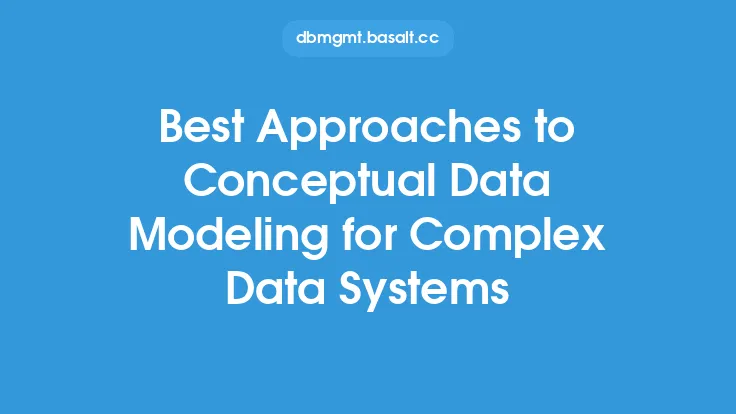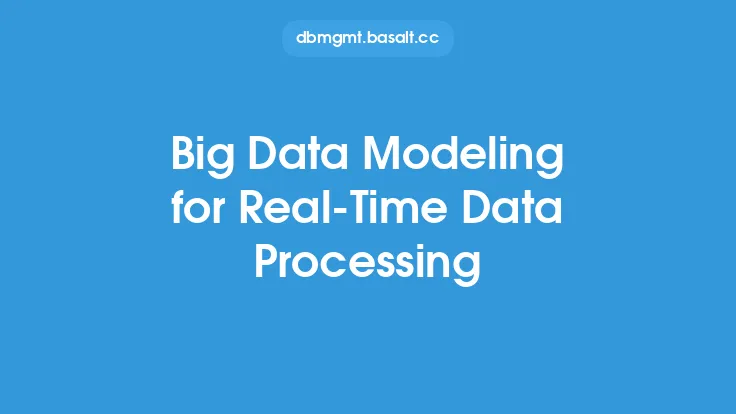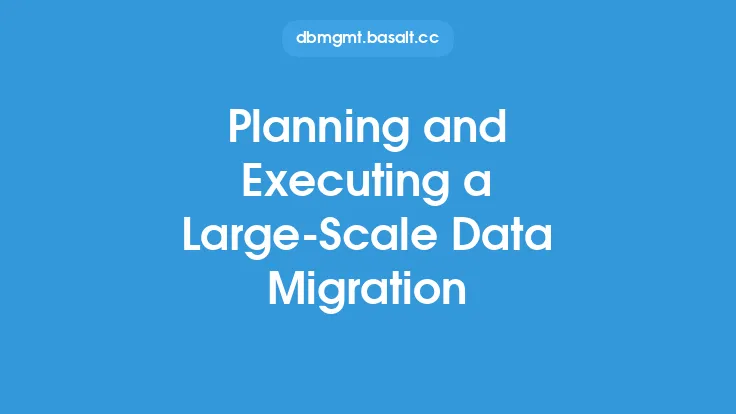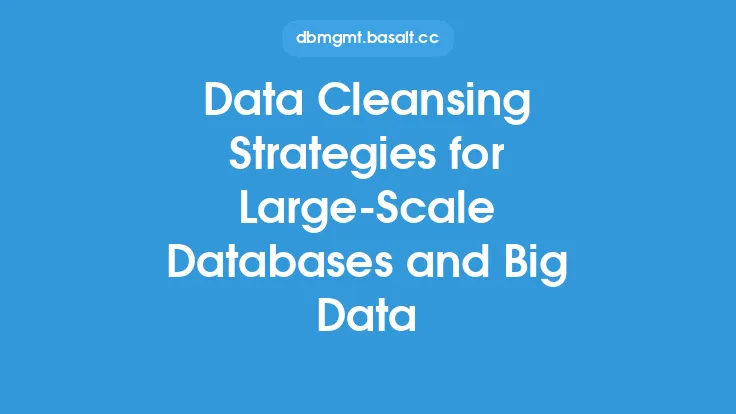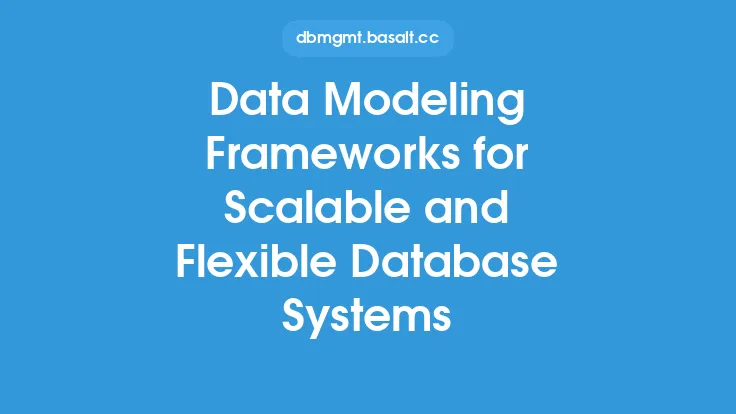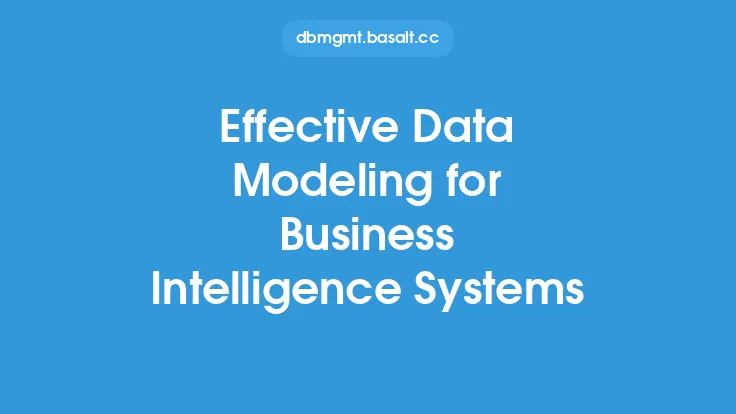When dealing with large scale data systems, data modeling plays a crucial role in ensuring that the data is properly organized, stored, and retrieved. Data modeling is the process of creating a conceptual representation of the data, which includes the relationships between different data entities, the data structures, and the data types. In the context of large scale data systems, data modeling is essential for several reasons. Firstly, it helps to ensure that the data is consistent and accurate, which is critical for making informed business decisions. Secondly, it enables the efficient storage and retrieval of large amounts of data, which is essential for big data analytics. Finally, it provides a framework for integrating data from different sources, which is critical for creating a unified view of the data.
Introduction to Data Modeling for Large Scale Data Systems
Data modeling for large scale data systems involves several key steps, including data discovery, data classification, data normalization, and data transformation. Data discovery involves identifying the different data sources and the types of data that are available. Data classification involves categorizing the data into different types, such as structured, semi-structured, and unstructured data. Data normalization involves ensuring that the data is consistent and accurate, which is critical for making informed business decisions. Data transformation involves converting the data into a format that is suitable for analysis, which is essential for big data analytics.
Data Modeling Techniques for Large Scale Data Systems
There are several data modeling techniques that can be used for large scale data systems, including entity-relationship modeling, object-oriented modeling, and dimensional modeling. Entity-relationship modeling involves creating a conceptual representation of the data, which includes the relationships between different data entities. Object-oriented modeling involves creating a model of the data that is based on objects and their relationships. Dimensional modeling involves creating a model of the data that is based on facts and dimensions, which is essential for big data analytics. Each of these techniques has its own strengths and weaknesses, and the choice of technique will depend on the specific requirements of the project.
Data Modeling Tools for Large Scale Data Systems
There are several data modeling tools that can be used for large scale data systems, including data modeling software, data governance tools, and data quality tools. Data modeling software provides a graphical interface for creating and editing data models, which is essential for large scale data systems. Data governance tools provide a framework for managing the data, including data security, data privacy, and data compliance. Data quality tools provide a framework for ensuring that the data is accurate and consistent, which is critical for making informed business decisions. Some popular data modeling tools include ER/Studio, PowerDesigner, and Informatica.
Data Warehousing and Data Modeling for Large Scale Data Systems
Data warehousing is a critical component of large scale data systems, and data modeling plays a key role in the design and implementation of data warehouses. A data warehouse is a centralized repository that stores data from different sources, which is essential for big data analytics. Data modeling is used to create a conceptual representation of the data, which includes the relationships between different data entities, the data structures, and the data types. This conceptual representation is then used to design and implement the data warehouse, which includes the creation of fact tables, dimension tables, and aggregate tables.
Big Data and Data Modeling for Large Scale Data Systems
Big data is a critical component of large scale data systems, and data modeling plays a key role in the design and implementation of big data analytics. Big data refers to the large amounts of structured, semi-structured, and unstructured data that are generated by different sources, including social media, sensors, and mobile devices. Data modeling is used to create a conceptual representation of the data, which includes the relationships between different data entities, the data structures, and the data types. This conceptual representation is then used to design and implement the big data analytics platform, which includes the creation of data pipelines, data lakes, and data warehouses.
Best Practices for Data Modeling in Large Scale Data Systems
There are several best practices that should be followed when data modeling for large scale data systems, including keeping the data model simple, using standardized data types, and using data governance tools. Keeping the data model simple is essential for ensuring that the data is easy to understand and maintain, which is critical for making informed business decisions. Using standardized data types is essential for ensuring that the data is consistent and accurate, which is critical for big data analytics. Using data governance tools is essential for ensuring that the data is secure, private, and compliant, which is critical for large scale data systems.
Common Challenges in Data Modeling for Large Scale Data Systems
There are several common challenges that are encountered when data modeling for large scale data systems, including data complexity, data volume, and data variety. Data complexity refers to the complexity of the data, which can make it difficult to create a conceptual representation of the data. Data volume refers to the large amounts of data that are generated by different sources, which can make it difficult to store and retrieve the data. Data variety refers to the different types of data that are generated by different sources, which can make it difficult to integrate the data into a unified view. These challenges can be addressed by using data modeling techniques, data modeling tools, and data governance tools.
Future of Data Modeling in Large Scale Data Systems
The future of data modeling in large scale data systems is exciting and rapidly evolving. With the increasing use of big data analytics, artificial intelligence, and machine learning, data modeling is becoming more critical than ever. Data modeling is being used to create conceptual representations of complex data systems, which is essential for making informed business decisions. Data modeling is also being used to design and implement data warehouses, data lakes, and data pipelines, which is essential for big data analytics. As the amount of data continues to grow, data modeling will play an increasingly important role in ensuring that the data is properly organized, stored, and retrieved.
